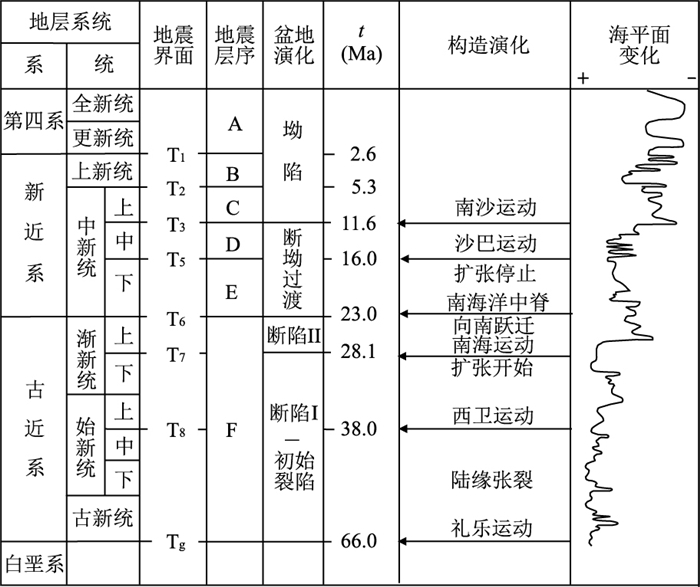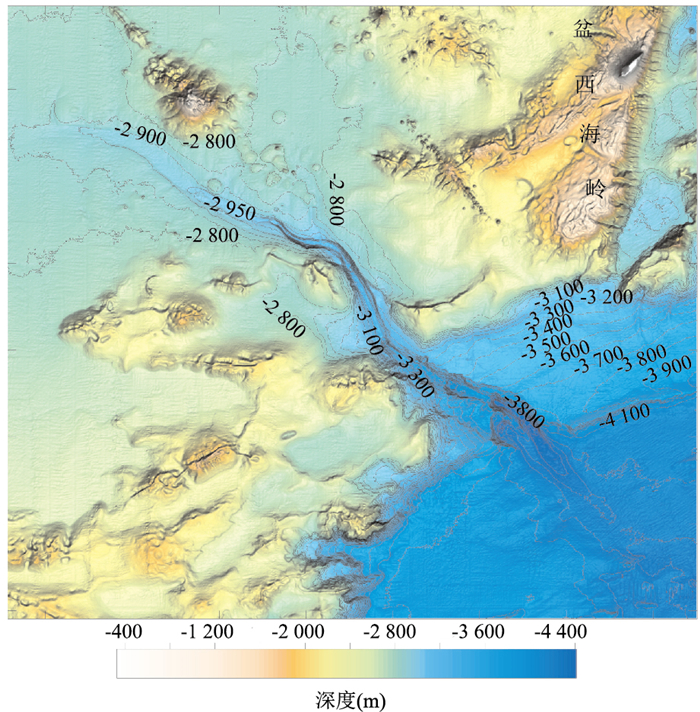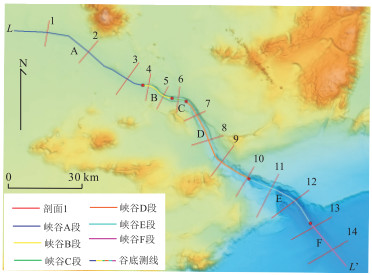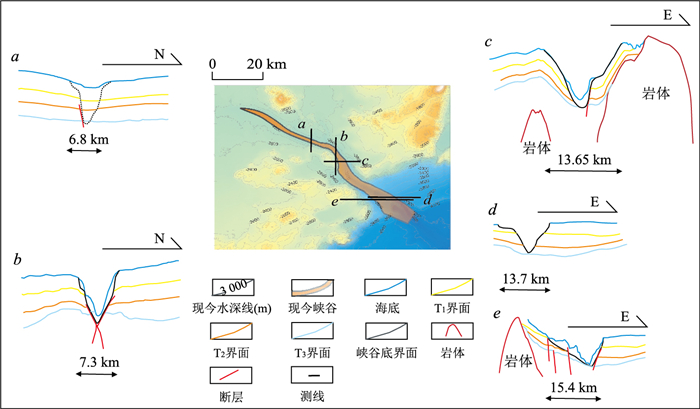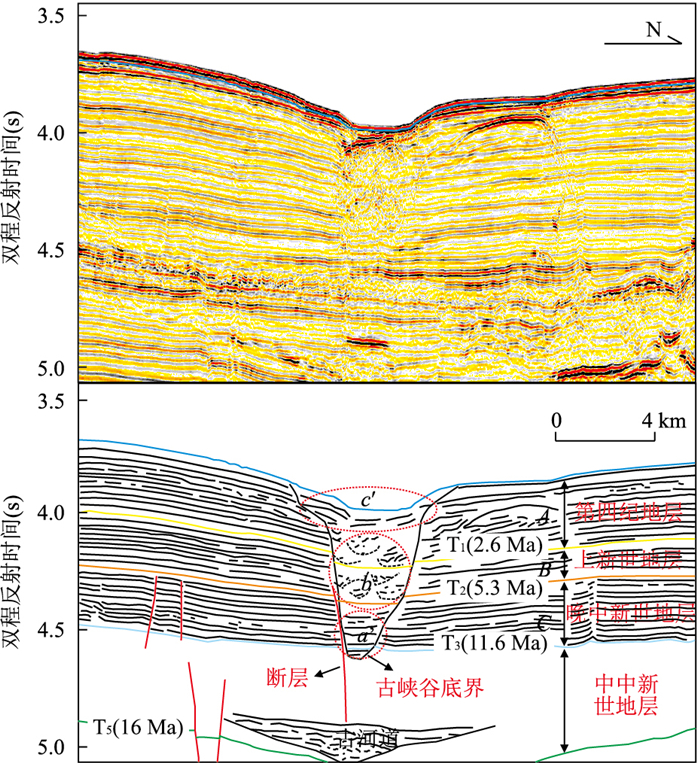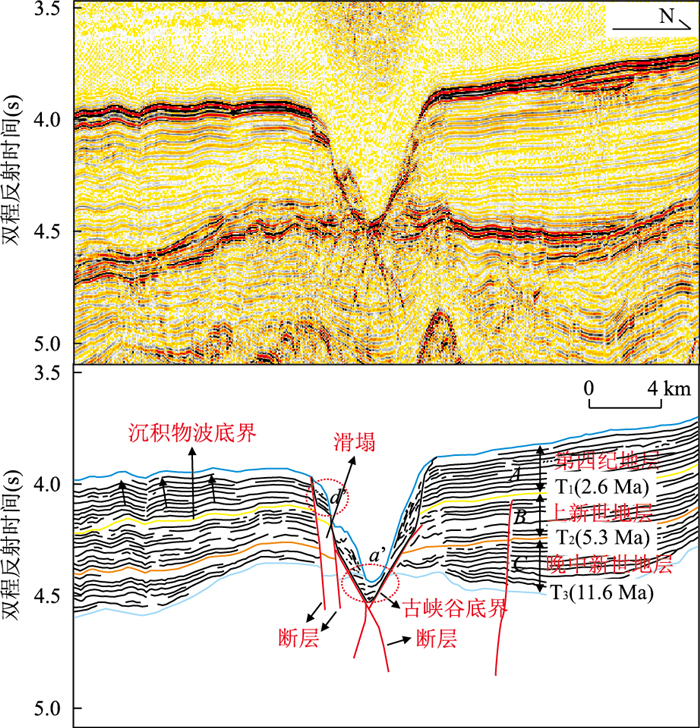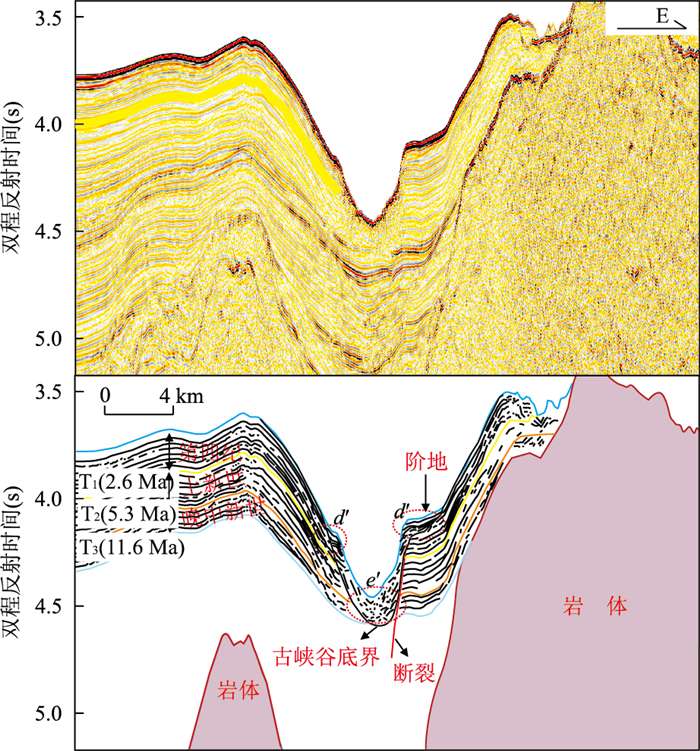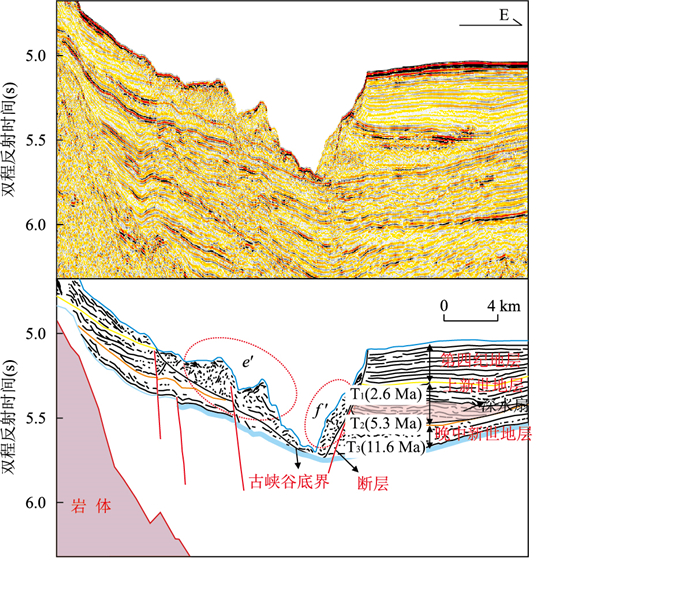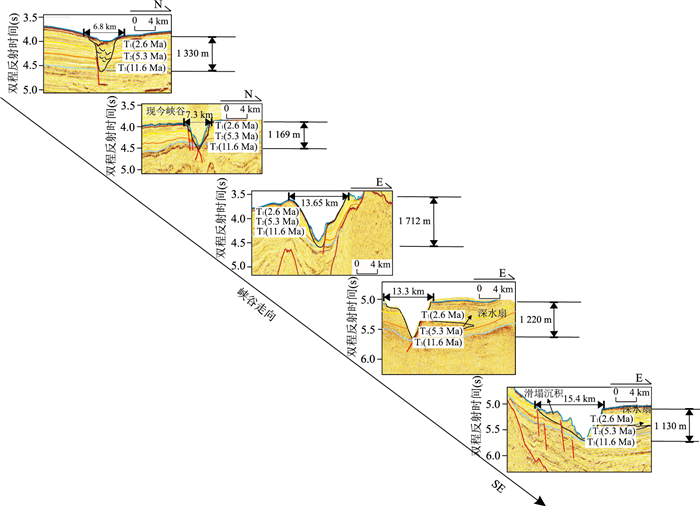Morphology and Structure and Evolution of West Basin Canyon, South China Sea
-
摘要: 盆西峡谷是南海中建南盆地中东部的一条大型峡谷,整体呈NW向,水深介于2 850~4 300 m,全长约188 km,宽为1.5~14.5 km,起始于中建南盆地,延伸到西南次海盆,对其进行形态、结构和形成演化的研究,为后续西南次海盆浊积扇的研究奠定了基础,对深入了解浊流沉积物的搬运模式提供科学依据.利用高分辨率多波束测深、单道和多道地震的最新资料,研究盆西峡谷的形态特征和结构及形成演化,结果表明盆西峡谷具有"分段性"特征,剖面形态从WN向ES依次表现为上段U型、中上段V型、中下段下V上U型和下段U型4段形态;上段以沉积作用为主,发育多期下切河道充填沉积,厚度可达1 200 m;中上段以侵蚀-沉积过渡作用为主,发育浊积水道砂体;中下段以冲刷作用为主,发育内堤岸和块体流沉积;下段发育块体流和滑塌体沉积.研究表明,盆西峡谷的形成受古地貌条件、侵蚀-沉积作用、海平面变化、构造运动和岩浆活动等多方面的影响,其中侵蚀-沉积作用、断裂活动和海平面变化为主控因素.揭示出盆西峡谷沉积演化可分为3个演化阶段:中中新世的峡谷蕴育阶段、晚中新世的峡谷侵蚀-充填阶段和上新世-第四纪的峡谷"回春"阶段.Abstract: The west basin canyon is a large cayon in the middle east of the Zhongjiannan basin in South China Sea. It appears to be NW direction, the depth of water is 2 850-4 300 m, and the length of it is about 188 km, the width is 1.8-14.5 km. It begins within the Zhongjiannan basin, and extends to the southwest sub-basin. The study of it provides a basis for the study of turbidite fan in the southwest sub-basin, and also provides scientific basis for deep understanding of the transportation model of turbidy currents. Based on the latest data of high resolution multi-beam depth sounding, single channel and multichannel seismic, this paper studies the morphological characteristics and structure and evolution of the west basin canyon. The results show the "segmentation" characteristics of the west basin canyon, including four stages:U type upper segment, V type middle upper segment, V bellow U type middle lower segment and U type lower segment, from the northwest to the southeast. The upper segment is mainly because of sedimentation processes, the infill of the multiphase incised valley reaches a thickness of 1 200 m; the middle-upper segment is mainly controlled by erosion-deposition, which leads to the formation of the turbidite sandstone body; the middle-lower segment is mainly controlled by erosion, which leads to the formation of the embankment and the mass flow deposit; the mass-flow and slip block deposited within the lower segment. The formation of the west basin canyon is influenced by palaeogeomorphology, erosion-deposition, sea-level change, tectonic movement, and magmatic activity, and the main controlling parameters are erosion-deposition, fault activity and sea-level change. The sedimentary evolution of the west basin canyon can be divided into 3 stages:the Middle Miocene canyon breeds stage, the Late Miocene sea canyon erosion and filling stage, the Pliocene-Quaternary canyon "rejuvenation" stage.
-
图 5 盆西峡谷谷底水深变化曲线
谷底测线位置见图 4中LL'
Fig. 5. The water depth change curve of bottom of the west basin canyon
表 1 盆西峡谷地形剖面主要地形参数特征
Table 1. The main terrain parameters in west basin canyon
剖面名称 峡谷分段 峡谷类型 长(km) 上顶部宽(km) 下底部宽(km) 下切深度(m) 谷底水深(m) 谷壁坡度(左,右) 1 A U型 63.4 6.8 3.9 52.0 2 817 2.3°,0.4° 2 8.3 2.4 70.0 2 932 1.2°,2.0° 3 7.3 2.0 95.0 2 988 2.4°,2.2° 4 B V型 14.5 4.7 157.1 3 090 10.6°,3.2° 5 1.6 239.2 3 255 18.6°,20.0° 6 C U型 5.8 2.1 1.2 129.3 3 220 11.1°,20.2° 7 D V型 45.2 3.5 457.8 3 421 17.4°,18.1° 8 4.2 221.1 3 342 5.9°,10.2° 9 5.5 368.0 3 538 9.2°,9.2° 10 7.1 470.5 3 804 5.7°,8.0° 11 E 上U 34.3 12.5 379.9 3 943 3.4°,7.0° 12 下V 12.7 572.3 4 382 10.4°,12.9° 13 F U型 24.8 10.9 2.6 142.2 4 329 1.6°,2.1° 14 6.6 2.0 32.2 4 255 0.6°,1.0° -
Alessandro, B., Domenico, R., Francesco, L.C., et al., 2009.The Impact of Small Scale Cyclical Landslides on Human Beings in the Continental Margin of the Italian Continental Margin.Marine Geology, (1):50 (in Chinese). Antobreh, A.A., Krastel, S., 2006.Morphology, Seismic Characteristics and Development of Cap Timiris Canyon, Offshore Mauritania:A Newly Discovered Canyon Preserved-off a Major Arid Climatic Region.Marine and Petroleum Geology, 23(1):37-59. https://doi.org/10.1016/j.marpetgeo.2005.06.003 Arzola, R.G., Wynn, R.B., Lastras, G., et al., 2008.Sedimentary Features and Processes in the Nazaré and Setúbal Submarine Canyons, West Iberian Margin.Marine Geology, 250(1-2):64-88. https://doi.org/10.1016/j.margeo.2007.12.006 Babonneau, N., Savoye, B., Cremer, M., et al., 2002.Morphology and Architecture of the Present Canyon and Channel System of the Zaire Deep-Sea Fan.Marine and Petroleum Geology, 19(4):445-467. https://doi.org/10.1016/s0264-8172(02)00009-0 Cande, S.C., Kent, D.V., 1995.Revised Calibration of the Geomagnetic Polarity Timescale for the Late Cretaceous and Cenozoic.Journal of Geophysical Research:Solid Earth, 100(B4):6093-6095. https://doi.org/10.1029/94jb03098 Chen, H.J., Cai, G.Q., Luo, W.D., et al., 2012.Features of Canyon Morphology and Their Origin in the Shenhu Area, Northern Slope of the South China Sea.Marine Geology & Quaternary Geology, 32(5):19-26 (in Chinese with English abstract). http://en.cnki.com.cn/Article_en/CJFDTOTAL-HYDZ201205006.htm Chen, L., 2006.Analysis of Structural Styles of Zhongjiannan Basin in the South China Sea.Marine Geology & Quaternary Geology, 26(1):53-58 (in Chinese with English abstract). http://en.cnki.com.cn/Article_en/CJFDTOTAL-HYDZ200601013.htm Fan, S.Q., Yu, X., 1977.Theoretical Problems of Modern Ocean Turbidity.Marine Sciences, 1(1):44-48 (in Chinese). Gao, H.F., Bai, Z.L., 2000.Modeling and Analysis of Structure Subsidence Historic and Filling Succession of Zhongjiannan Basin.Geological Research of South China Sea, (12):33-43 (in Chinese with English abstract). http://en.cnki.com.cn/Article_en/CJFDTotal-NHDZ200000003.htm Gao, H.F., Bai, Z.L., Guo, Y.Q., 2000.Cenozoic Sedimentary Facies and Palaeogeographic Evolution of Zhongjiannan Basin, South China Sea.China Offshore Oil and Gas (Geology), 14(6):411-416 (in Chinese with English abstract). Gao, H.F., Chen, L., 2006.An Analysis of Structural Framework and Formation Mechanism of Zhongjiannan Basin in the West of South China Sea.Oil & Gas Geology, 27(4):512-516 (in Chinese with English abstract). http://en.cnki.com.cn/Article_en/CJFDTOTAL-SYYT200604011.htm Gingele, F.X., de Deckker, P., Hillenbrand, C.D., 2004.Late Quaternary Terrigenous Sediments from the Murray Canyons Area, Offshore South Australia and Their Implications for Sea Level Change, Palaeoclimate and Palaeodrainage of the Murray-Darling Basin.Marine Geology, 212(1-4):183-197. https://doi.org/10.1016/j.margeo.2004.09.001 Harris, P.T., Whiteway, T., 2011.Global Distribution of Large Submarine Canyons:Geomorphic Differences between Active and Passive Continental Margins.Marine Geology, 285(1-4):69-86. https://doi.org/10.1016/j.margeo.2011.05.008 He, Y.L., Xie, X.N., Lu, Y.C., et al., 2011.Architecture and Characteristics of Mass Transport Deposits (MTDs) in Qiongdongnan Basin in Northern South China Sea.Earth Science, 36(5):905-913 (in Chinese with English abstract). https://doi.org/10.3799/dqkx.2011.095 Jin, Q.H., 1989.Oil and Gas Resource and Geology of South China Sea.Geological Publishing House, Beijing (in Chinese). Kuenen, P.H., 1937.Experiments in Connection with Daly's Hypothesis on the Formation of Submarine Canyons.Leidse Geologische Mededelingen, 8:327-351. http://www.narcis.nl/publication/RecordID/oai%3Anaturalis.nl%3A505608 Laursen, J., Normark, W.R., 2002.Late Quaternary Evolution of the San Antonio Submarine Canyon in the Central Chile Forearc (~33°S).Marine Geology, 188(3-4):365-390. https://doi.org/10.1016/s0025-3227(02)00421-8 Li, J.B., Ding, W.W., Wu, Z.Y., et al., 2012.The Propagation of Seafloor Spreading in the Southwestern Subbasin, South China Sea.Chinese Science Bulletin, 57(20):1896-1905 (in Chinese). doi: 10.1007/s11434-012-5329-2 Li, W., Wu, S.G., Wang, X.J., et al., 2013.Seismic Characteristics and Distribution of Pliocene Mass Transport Deposits in Central Canyon of Qiongdongnan Basin.Marine Geology & Quaternary Geology, 33(2):9-15 (in Chinese with English abstract). http://en.cnki.com.cn/Article_en/CJFDTOTAL-HYDZ201302002.htm Liu, S.Q., Liu, X.Q., Wang, S.J., et al., 2000.Kinds of Hazardous Geology and Division in South China Sea.The Chinese Journal of Geological Hazard and Control, 11(4):39-44 (in Chinese with English abstract). http://en.cnki.com.cn/Article_en/CJFDTOTAL-ZGDH200004009.htm Mayall, M., Jones, E., Casey, M., 2006.Turbidite Channel Reservoirs-Key Elements in Facies Prediction and Effective Development.Marine and Petroleum Geology, 23(8):821-841. https://doi.org/10.1016/j.marpetgeo.2006.08.001 McHugh, C.M.G., Damuth, J.E., Mountain, G.S., 2002.Cenozoic Mass-Transport Facies and Their Correlation with Relative Sea-Level Change, New Jersey Continental Margin.Marine Geology, 184(3-4):295-334. https://doi.org/10.1016/s0025-3227(01)00240-7 Mitchum, R, M., Vail, P.R., Sangree, J.B., 1977.Seismic Stratigraphy and Global Changes of Sea Level, Part 6:Stratigraphic Interpretation of Seismic Reflection Patterns in Depositional Sequences.In:Payton, C.ed., Seismic Stratigraphy-Applications to Hydrocarbon Exploration.AAPG Memoir, 26:117-134. http://geoscienceworld.org/georef/1979-013397 Orange, D.L., Breen, N.A., 1992.The Effects of Fluid Escape on Accretionary Wedges 2.Seepage Force, Slope Failure, Headless Submarine Canyons, and Vents.Journal of Geophysical Research, 97(B6):9277-9295. https://doi.org/10.1029/92jb00460 Popescu, I., Lericolais, G., Panin, N., et al., 2004.The Danube Submarine Canyon (Black Sea):Morphology and Sedimentary Processes.Marine Geology, 206(1-4):249-265. https://doi.org/10.1016/j.margeo.2004.03.003 Posamentier, H.W., Jervey, M.T., Vail, P.R., 1988.Eustatic Control on Clastic Deposition Ⅰ-Conceptual Framework.Sea Level Changes-An Integrated Approach, (42):109-124. https://doi.org/10.2110/pec.88.01.0109 Su, M., Jiang, T., Zhang, C.M., et al., 2014a.Characteristics of Morphology and Infillings and the Geological Significances of the Central Canyon System in Eastern Qiongdongnan Basin.Journal of Jilin Unviersity(Earth Science Edition), 44(6):1805-1815 (in Chinese with English abstract). http://xuebao.jlu.edu.cn/dxb/EN/Y2014/V44/I6/1805 Su, M., Zhang, C., Xie, X.N., et al., 2014b.Controlling Factors on the Submarine Canyon System:A Case Study of the Central Canyon System in the Qiongdongnan Basin, Northern South China Sea.Science China:Earth Sciences, 44(8):1807-1820 (in Chinese). http://210.77.90.120/handle/344004/10601?mode=full&submit_simple=Show+full+item+record Su, M., Xie, X.N., Wang, Z.F., et al., 2013.Sedimentary Evolution of the Central Canyon System in Qiongdongnan Basin, Northern South China Sea.Acta Petrolei Sinica, 34(3):467-478 (in Chinese with English abstract). http://en.cnki.com.cn/Article_en/CJFDTOTAL-SYXB201303008.htm Su, M., Xie, X.N., Xie, Y.H., et al., 2014.The Segmentations and the Significances of the Central Canyon System in the Qiongdongnan Basin, Northern South China Sea.Journal of Asian Earth Sciences, 79:552-563. https://doi.org/10.1016/j.jseaes.2012.12.038 Twichell, D.C., Roberts, D.G., 1982.Morphology, Distribution, and Development of Submarine Canyons on the United States Atlantic Continental Slope between Hudson Arid Baltimore Canyons.Geology, 10(8):408.https://doi.org/10.1130/0091-7613(1982)10<408:mdados>2.0.co;2 doi: 10.1130/0091-7613(1982)10<408:mdados>2.0.co;2 Wan, L., Wu, N.Y., Yao, B.C., et al., 2003.Cenozoic Tectonic Movement and the Genetic Discussion in Nan Sha Sea Area.Geological Research of South China Sea, (1):8-16 (in Chinese with English abstract). http://en.cnki.com.cn/Article_en/CJFDTotal-NHDZ200300001.htm Wang, Y.T., Chen, L., Wu, D.M., 2006.Velocity Data Analysis and Its Application to Zhongjiannan Basin in South China Sea.Journal of Tropical Oceanography, 25(5):49-55 (in Chinese with English abstract). http://en.cnki.com.cn/Article_en/CJFDTOTAL-RDHY200605008.htm Wonham, J.P., Jayr, S., Mougamba, R., et al., 2000.3D Sedimentary Evolution of a Canyon Fill (Lower Miocene-Age) from the Mandorove Formation, Offshore Gabon.Marine and Petroleum Geology, 17(2):175-197. https://doi.org/10.1016/s0264-8172(99)00033-1 Xu, H.Z., Cai, D.S., Sun, Z.P., et al., 2012.Filling Characters of Central Submarine Canyon of Qiongdongnan Basin and Its Significance of Petroleum Geology.Acta Geologica Sinica, 86(4):641-650 (in Chinese with English abstract). http://en.cnki.com.cn/Article_en/CJFDTOTAL-DZXE201204010.htm Xu, S., Wang, Y.M., Peng, X.C., et al., 2014.Origin of Taiwan Canyon and Its Effects on Deepwater Sediment.Science China:Earth Sciences, 44(9):1913-1924 (in Chinese). doi: 10.1007/s11430-014-4942-0 Yao, B.C., 1997.The Sea Floor Spreanding in the SW Subbasin of South China Sea and It's Tectonic Significance.Geological Research of South China Sea, (9):20-36 (in Chinese with English abstract). Yao, B.C., Qiu, Y., Wu, N.Y., et al., 1999.Geological and Tectonic Characteristics and Cenozoic Sedimentation of the Western South China Sea.Geological Publishing House, Beijing, 45-55 (in Chinese). Yao, B.C., Zeng, W.J., Hayes, D.E., et al., 1994.The Geological Memoir of South China Sea Surveyed Jointly by China & USA.China University of Geosciences Press, Wuhan (in Chinese). Yin, S.R., Wang, L.L., Guo, Y.Q., et al., 2015.Morphology, Sedimentary Characteristics, and Origin of the Dongsha Submarine Canyon in the Northeastern Continental Slope of the South China Sea.Science China:Earth Sciences, 45(3):275-289 (in Chinese). doi: 10.1007/s11430-014-5044-8 Zhong, G.J., Gao, H.F., 2005.Sequence Characteristics of Cenozoic Stratigraphy in Zhongjiannan Basin, South China Sea.Geotectonica et Metallogenia, 29(3):403-409 (in Chinese with English abstract). http://en.cnki.com.cn/Article_en/CJFDTOTAL-DGYK200503017.htm Zhou, D., Sun, Z., Chen, H.Z., 2007.Tectonic Features of World's Major Deep-Water Oil/Gas Fields and Their Enlightenment to Deep-Water Exploration in Northern South China Sea.Advances in Earth Science, 22(6):561-572 (in Chinese with English abstract). http://en.cnki.com.cn/Article_en/CJFDTOTAL-DXJZ200706002.htm Alessandro, B., Domenico, R., Francesco, L.C., 等, 2009.意大利陆缘海底峡谷内小规模周期性滑坡对人类的影响扩大.海洋地质, (1):50. http://www.cqvip.com/QK/97338X/200901/30124072.html 陈泓君, 蔡观强, 罗伟东, 等, 2012.南海北部陆坡神狐海域峡谷地貌形态特征与成因.海洋地质与第四纪地质, 32(5):19-26. http://www.cnki.com.cn/Article/CJFDTotal-HYDZ201205006.htm 陈玲, 2006.南海中建南盆地构造样式分析.海洋地质与第四纪地质, 26(1):53-58. http://www.wanfangdata.com.cn/details/detail.do?_type=perio&id=hydzydsjdz200601009 范时清, 俞旭, 1977.现代海洋浊流作用理论问题.海洋科学, 1(1):44-48. http://www.cnki.com.cn/Article/CJFDTOTAL-HYKX197701009.htm 高红芳, 白志琳, 2000.南海中建南盆地构造沉降分析及沉积充填序列.南海地质研究, (12):33-43. http://cdmd.cnki.com.cn/Article/CDMD-10491-1012460900.htm 高红芳, 白志琳, 郭依群, 2000.南海西部中建南盆地新生代沉积相及古地理演化.中国海上油气(地质), 14(6):411-416. http://www.wanfangdata.com.cn/details/detail.do?_type=perio&id=zghsyq-dz200006007 高红芳, 陈玲, 2006.南海西部中建南盆地构造格架及形成机制分析.石油与天然气地质, 27(4):512-516. doi: 10.11743/ogg20060411 何云龙, 解习农, 陆永潮, 等, 2011.琼东南盆地深水块体流构成及其沉积特征.地球科学, 36(5):905-913. https://doi.org/10.3799/dqkx.2011.095 金庆焕, 1989.南海地质与油气资源.北京:地质出版社. 李家彪, 丁巍伟, 吴自银, 等, 2012.南海西南海盆的渐进式扩张.科学通报, 57(20):1896-1905. http://mall.cnki.net/magazine/Article/KXTB201220008.htm 李伟, 吴时国, 王秀娟, 等, 2013.琼东南盆地中央峡谷上新统块体搬运沉积体系地震特征及其分布.海洋地质与第四纪地质, 33(2):9-15. http://www.cqvip.com/QK/96122X/201302/45652675.html 刘守全, 刘锡清, 王圣洁, 等, 2000.南海灾害地质类型及分区.中国地质灾害与防治学报, 11(4):39-44. https://www.wenkuxiazai.com/doc/a4e4fb2202768e9950e7383f.html 苏明, 姜涛, 张翠梅, 等, 2014a.琼东南盆地中央峡谷体系东段形态充填特征及其地质意义.吉林大学学报(地球科学版), 44(6):1805-1815. http://www.oalib.com/paper/4355822 苏明, 张成, 解习农, 等, 2014b.深水峡谷体系控制因素分析——以南海北部琼东南盆地中央峡谷体系为例.中国科学:地球科学, 44(8):1807-1820. http://www.cnki.com.cn/Article/CJFDTOTAL-CJXB201204004.htm 苏明, 解习农, 王振峰, 等, 2013.南海北部琼东南盆地中央峡谷体系沉积演化.石油学报, 34(3):467-478. doi: 10.7623/syxb201303007 万玲, 吴能友, 姚伯初, 等, 2003.南沙海域新生代构造运动特征及成因探讨.南海地质研究, (1):8-16. http://www.cqvip.com/QK/91083X/200300/678726890200300001.html 王衍棠, 陈玲, 吴大明, 2006.南海中建南盆地速度资料分析与应用.热带海洋学报, 25(5):49-55. http://d.wanfangdata.com.cn/Periodical_rdhy200605009.aspx 许怀智, 蔡东升, 孙志鹏, 等, 2012.琼东南盆地中央峡谷沉积充填特征及油气地质意义.地质学报, 86(4):641-650. http://www.wanfangdata.com.cn/details/detail.do?_type=perio&id=dizhixb201204010 徐尚, 王英民, 彭学超, 等, 2014.台湾峡谷的成因及其对沉积的控制.中国科学:地球科学, 44(9):1913-1924. http://www.oalib.com/paper/4152511 姚伯初, 1997.南海西南次海盆海底扩张及构造意义.南海地质研究, (9):20-36. http://mall.cnki.net/magazine/Article/JDXK201110009.htm 姚伯初, 邱燕, 吴能友, 等, 1999.南海西部海域地质构造特征和新生代沉积.北京:地质出版社, 45-55. 姚伯初, 曾维军, Hayes, D. E., 1994.中美合作调研南海地质专报.武汉:中国地质大学出版社. 殷绍如, 王嘹亮, 郭依群, 等, 2015.东沙海底峡谷的地貌沉积特征及成因.中国科学:地球科学, 45(3):275-289. http://www.cnki.com.cn/Article/CJFDTOTAL-JDXK201503003.htm 钟广见, 高红芳, 2005.中建南盆地新生代层序地层特征.大地构造与成矿学, 29(3):403-409. http://www.wanfangdata.com.cn/details/detail.do?_type=perio&id=ddgzyckx200503016 周蒂, 孙珍, 陈汉宗, 2007.世界著名深水油气盆地的构造特征及对我国南海北部深水油气勘探的启示.地球科学进展, 22(6):561-572. http://www.cnki.com.cn/Article/CJFDTotal-DXJZ200706002.htm -









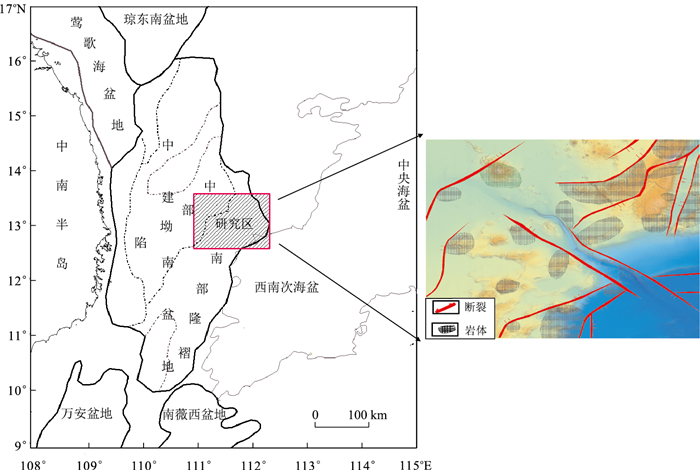
 下载:
下载:
